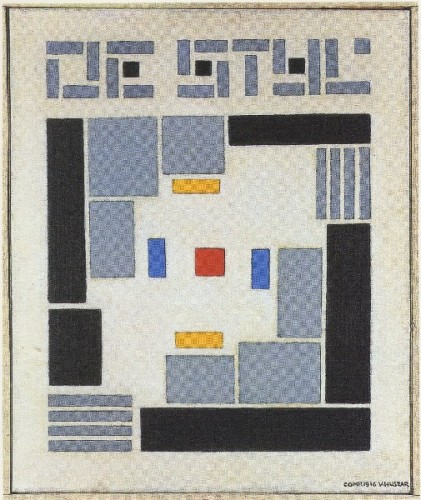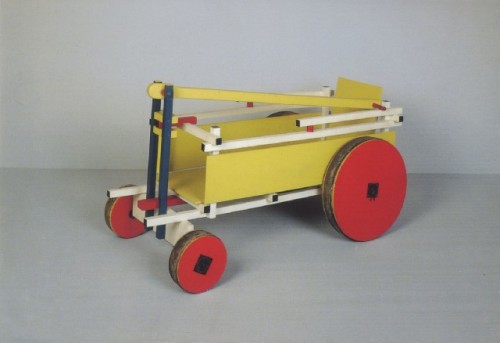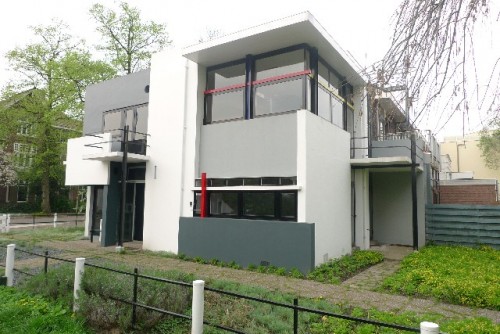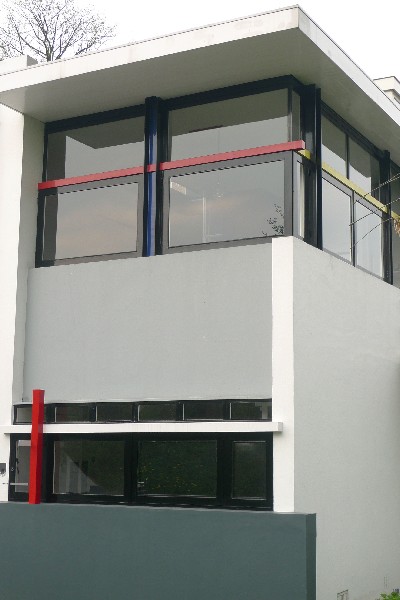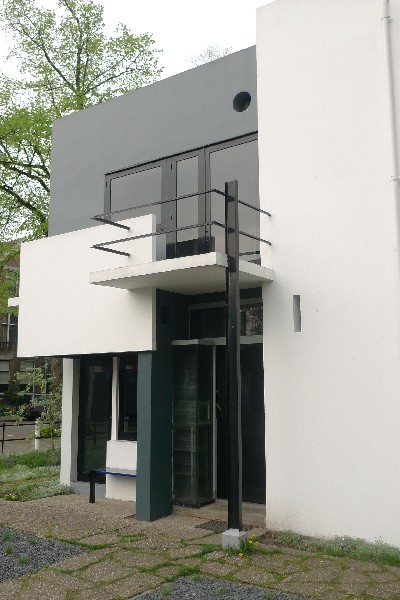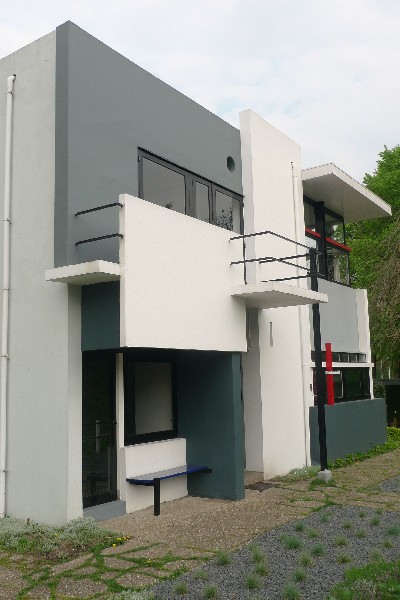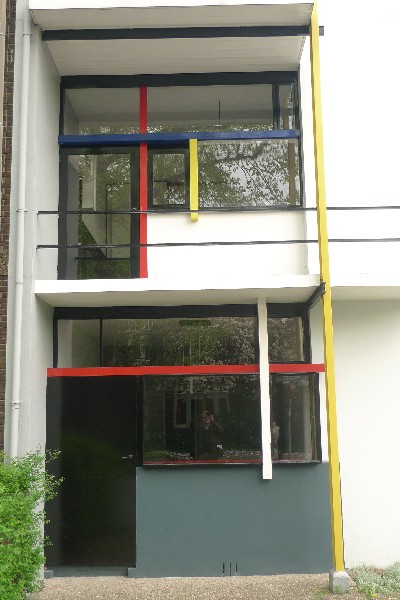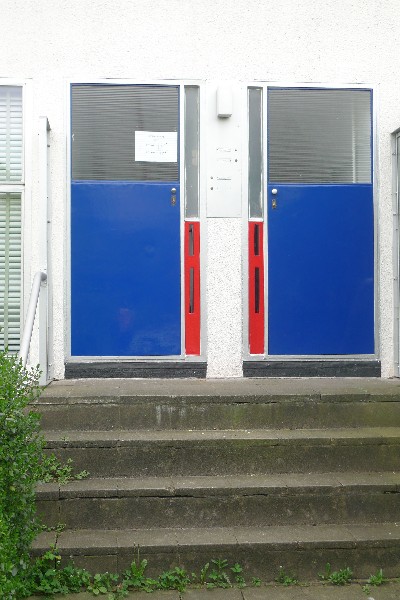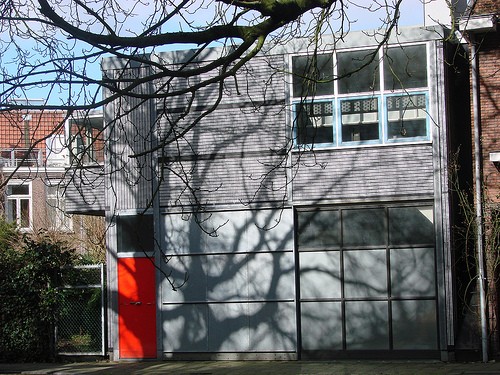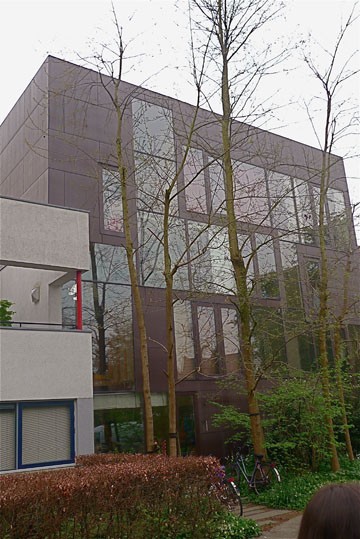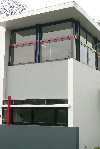Unique Rietveld-Schroeder House in Utrecht
Only De Stijl House Ever Built
By: Mark Favermann - May 04, 2009
Rietveld-Schroeder Huis
Visits to the house by conducted tour: € 15
Unaccompanied visit with audiotour: € 8
Visits to the house with audiotour only.
This is possible on Wednesday, at fixed times: 11.00, 13.00, 14.00; 15.00 and 16.00 hours, and on Thursday through Sunday at 15.00 and 16.00 hours.
During each blocked hour there is room in the house for a maximum of 10 persons.
Visit to the house with guided tour
There are guided tours Thursdays to Sundays at 11.00, 12.00, 13.00 and 14.00 hours. These guided tours last an hour and a quarter and include a visit to the model Bauhaus dwelling at Erasmuslaan 9. The commentary on these guided tours will be in either Dutch or English, according to the composition of the group.
Reservations are strongly recommended: Call 0031 30 2362 310, or rhreserveringen@centraalmuseum.nl
On my recent trip to Europe, my plane had an extended layover in Amsterdam. I love quests, so I planned one before I left Boston. I was interested in seeing one of the unique structures in in the world. So, I journeyed by train from the airport to the rather ancient university city of Utrecht, The Netherlands to see one of the most austerely sculptural houses ever built, the Rietveld-Schroeder Huis. The house was designed and built in 1924 by Gerrit Rietveld.
A Dutch architect and furniture designer of extraordinary talent, Rietveld (1888-1964) was still an architectural student in 1916 when he started his own furniture factory in his hometown of Utrecht. His father had a joinery business at which he had previously worked. Rietveld then apprenticed in a jeweler's studio. During his student years, he became familiar with the work and theories of other Dutch artists and designers. Ever experimenting with form, materials and construction methods, he produced a variety of furniture designs and especially iconic chairs in a straightforward strategically simplified abstracted way.
His classic Red and Blue geometrically elegant and spare chair was created in 1917. Influenced by the Dutch group De Stijl, he changed the colors to all three primaries and black in 1918. De Stijl or The Style in English was also known as neoplasticism and refers to a body of work from 1917 to 1931. Most prominent among its members were painters Piet Mondrian, Vimoz Huszar and Bart van der Leck and architects Robert van 't Hoff and J.J. P. Oud. It was also the name of a journal published by the Dutch painter/designer/critic Theo van Doesburg (1883-1931) which expounded upon the group's theories. It was founded in 1917. Rietveld became a member of the group in 1919. This was the same year that he became a professional architect.
The members of De Stijl sought to express through their art and design a utopian ideal of spiritual order and harmony. They advocated a pure abstraction through reduction to essential form and basic primary colors (red, yellow and blue) along with black and white. They simplified visual compositions to only vertical and horizontal straight line directions. In other words, De Stijl purposely ignored natural form and naturalistic color. Its focus was upon the fundamental principle of the geometry of the straight line, the square and the rectangle combined with a strong asymmetry. This was underscored by the use of the pure primary colors with black and white in a relationship between positive and negative elements and spaces in an arrangement of non-objective forms and lines.
In 1924, he designed his first building, the Rietveld-Schroeder Huis, the only De Stijl building ever completed. It was designed in close collaboration with with the woman who commissioned it., a young widow with three children, Truus Schroeder -Schrader. She had a great modern vision and a severe aesthetic discipline. The influence of this thoroughly modern woman was so strong that she made Rietveld complete the house in a rigidly right angled, nothing curvilinear way. She was the ultimate collaborative client. For the next 40 years, her life and lifestyle were dictated by this radically spare design.
There are comprehensive tours available at the Rietveld-Schroeder House that are given by reservations only four times a day. The tours are only for ten people at a time. As I had not made a reservation, I was lucky that a Swedish architectural class only had nine members, and I was allowed to join them. The tours are extremely well-done. The house is sculpturally spectacular on the outside. It is set on one side by a traditional and quite lovely upper middle class Utrecht neighborhood. On the other side it faces an elevated highway. When the house was built, there was only a large wooded area that the front and side of the house faced. The highway was built several years later. The wooded property was taken by eminent domain for the elevated highway. So now the site is quite different than initially planned.
Apparently, when Rietveld and his collaborating client showed the plans for the house to the appropriate Utrecht authorities, the architect finessed various aspects of the construction by the manipulation of drawings and plans. This was shown in sketchy renderings and concept drawings that suggested a structure roughly equivalent in volume and with a building height similar to the adjacent properties. The basement somehow was suggested as another above ground floor. When construction was completed, the resulting truth was far from the earlier shared and officially approved drawings and plans.
When the City of Utrecht authorities threatened to have the structure torn down, artists, architects and academics from all over Europe wrote letters in support of the house's design. The city fathers of Utrecht were persuaded that even though the house looked like no other, it was an important and even major contemporary design in 1924. Thus architect Rietveld and client Schroeder ultimately won the aesthetic conflict, and the house was allowed to remain as it was and become home to the Schroeder family. Interestingly, two of the three children who grew up there eventually became architects. The Rietveld-Schroeder House was designated a UNESCO World Heritage site in 2000.
The exterior of the house is rectilinear and asymmetrical like all of the De Stijl paintings. The severe 90 degree angles were apparently dictated by Mrs. Schroeder. She was interested in living in a completely modern structure. The railing design on the balcony is an example of the total rather wonderfully severe aesthetic. Overall, there is a special spare elegance to the buildings elements individually and as a whole. The facade is made out of a plaster over board and steel or iron structures. This construction predated cost-effective pre-cast concrete fabrication methods. Black and white as well as gray are the dominant colors with very occasional poetic touches of red, blue or yellow primary colors.
This is house as sculpture, house as painting. This is a design with an aesthetic essence. Here, colors are functional visual references emphasizing aspects of the house like entrances, windows and delivery of parcels. The sum is greater than the parts, but what provocative, even visually poetic, beautiful parts! For most individuals, this structure was too radical for comfort, but for Mrs. Schroeder this was her home with all that it applied.
The Rietveld-Schroeder House is actually a small house. Yet, the interior is a strangely visionary large space. The ground floor is rather conventional with small rooms while the top floor is schematically radical with an open plan and no fixed interior walls. The top floor has many specially designed aspects-movable walls which allow a variety of configurations, various screening devices, hidden air circulation slots, room dividers, advanced window treatments, etc. Each room in the house had running water and a sink. These were cleverly hidden by panels and rather invisible doors. Mrs. Schroeder felt that water was an important aspect of good living.
In the interior of the house, where unfortunately no photos are allowed, there were a few blow ups of the house when it was in use. The images showed that the hard severity of the furniture and house had a lived in softer quality. A major design consideration of the house was to incorporate existing off the shelf hardware and fittings. This was done for practicality and cost considerations. So, certain elements, like brass hinges and even a coat rack have decoration on them as they would have been produced in 1924. Sometimes Rietveld would turn the pieces around to have a plainer side on view. The only major custom fitting that was created for the house were horizontal radiators rather than the conventional vertical radiator arrangements. The horizontal lines were more fitting for the interior design.
Designer Rietveld made creative highly functional use of space. His designs are examples of a profound understanding of dynamic spatial relationships. The overall design of the house is somewhat like a three dimensional Mondrian painting. The austere rather rigid Rietveld-designed furniture was made a bit more comfortable by cushions and pillows as Mrs. Schroeder grew older. She lived there over 40 years. When the Schroeder children grew up and moved away, Mrs. Schroeder rented out rooms in the house. She lived upstairs. Gerrit Rietveld actually lived in the bottom section of the house in the late 1950s and early 60s as a boarder.
In 1928, Rietveld broke with the De Stijl Movement and switched to the Congres Internationaux D'Architecture Moderne taking a more Bauhaus, less polemically rigid approach to his work. Perhaps it was something about diagonal lines? In the late '20s, he went on to design two Bauhaus style buildings now located across the expressway from the Schroeder House. This was on land owned by Mrs. Schroeder and was part of the trend in social housing. These terrace house structures are still being lived in today, and one is shown on the Rietveld-Schroeder tour. Here, primary colors are used as visual emphasis on entrance doors.
A few blocks away from the Rietveld-Schroeder House overlooking a beautiful Utrecht park is a slightly later Rietveld house. This house , actually an addition to an existing home, was created for a prominent doctor. It is referred to as the Chauffeur's House (1927-28), and it clearly demonstrates a more Bauhaus stylistic approach. Here, Rietveld was able to use concrete as a building material. Nearby to this house is a cleverly designed contemporary two family house by the architectural firm of MVRDV built 1995-1997. Two families that had uneven amounts to invest in the project decided to join together to have the structure built. The trick here was to divide up a house 60/40 which was achieved by use of windows and glass. Thus, the great Dutch modern design tradition is continued 70 years later.
In 1932, Rietveld created his iconic Zig-Zag Chair. He continued to experiment with chair and furniture forms. Unfortunately, with few exceptions, the 1930s and 1940s were not a very productive period for Rietveld. Between 1942 and 1948, he taught at a number of academic institutions in The Netherlands. So for most of his career, Rietveld was often more the furniture maker/academic rather than a major architectural practitioner. In the 1950s, his work became more celebrated, and he was eventually appointed city architect for Utrecht. He died in 1964 before the design for his largest commission, Amsterdam's Van Gogh Museum, was completed. Though Rietveld is best known for his iconic furniture designs that are still in production, his Schroeder House is a unique world monument to his design genius.

